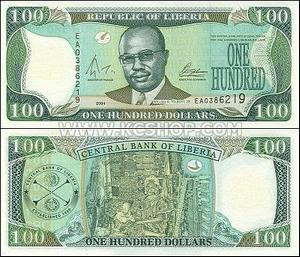The Government of Liberia, through its Technical Economic Management Team (TEMT) and the Central Bank of Liberia (CBL), was bound to fail when they “believed” that they could directly or indirectly influence the foreign exchange rate by infusing $25 Million USD (Twenty Five Million United States Dollars) into the Liberian economy through a “mop-up” exercise.
In mid-July of 2018, the President of the Republic of Liberia, Dr. George Manneh Weah, addressed the Nation, spoke passionately on the state of the economy, and announced an immediate infusion by the Central Bank of Liberia the amount of $25 USD Million to mop-up excess liquidity of Liberian dollars. The exercise was to serve as a means to mitigate the volatility in the exchange rate, maintain broad stability of the Liberian Dollar, and by extension, maintain price stability.
In macro-economics, this process is often referred to as Foreign Currency Intervention, wherein a central bank of a country acts like any other trader in the currency market – albeit a big one. If the goal was to increase the value of the domestic currency, the central bank would purchase its own currency using its foreign exchange reserves, at least to the acceptable limits that it could endure depleting its reserves. This was the case with Liberia, who decided to use a direct intervention to achieve foreign exchange rate stability.
Direct intervention was the primary method used by many countries for many years, but beginning in the 1970s, the world’s currency markets grew enough that any individual player, even a central bank, could find itself with insufficient resources to move the market and influence the exchange rate. It is a known fact that foreign currency intervention can, and often does, fail.
There are many examples of countries that have used the intervention methods and drastically failed. The Turkish currency crisis in 2014, the Asian crisis of 1997, the collapse of the Argentine’s Peso in 2002, the Japanese Yen crisis of 2010, the Thai Baht currency intervention nightmare, and the Venezuelan hyper-inflation crisis are all major and global examples showing the downside of direct or indirect intervention by governments to influence exchange rates.
Immediately, this knowledge brings a lot of questions to mind. Was the Government of Liberia knowledgeable of the facts of direct intervention and went along with it anyway? Or is the Government inexperienced, unknowledgeable, and untrained enough not to understand economic issues? To get any semblance of understanding, and answer these questions, we only have to critically look at the entire process of the “mop-up” exercise.
Following President George Weah’s announcement of the “mop-up” exercise, the Central Bank of Liberia (CBL), under the mandate of the TEMT, carried out the Exercise during the period July 17, 2018 to October 30, 2018, and later extended it up to February 2019. The report provided by the CBL on the Mop-up Exercise shows that the amount of $15 Million USD was used for direct mop-up of excess Liberian Dollars from Large importers, small businesses and foreign exchange bureaus, while the amount of $2 Million USD was auctioned to TOTAL Liberia Inc.
Growing out of the Presidential Investigation Team’s Report, which called for a forensic investigation of the entire Mop-up Exercise carried out by the CBL, and the Scoping Report done by the Kroll Associates Inc., which also called for a further understanding of the Mop-up Exercise, the President of Liberia requested the General Auditing Commission (GAC) to conduct an investigative audit into the $25 Million USD earmarked for the mop-up exercise through the Minister of Justice /Attorney General.
The GAC provided possible alternative approaches to the President’s request such as a Forensic Audit or an Agreed Upon Procedure (AUP) Engagement. The GAC set forth conditions relating to the conduction of both approaches, and the Government of Liberia, through the Minister of Justice/Attorney General, opted for an Agreed Upon Procedure to be performed on the Exercise.
According to the GAC’s AUP Report released in May 2019, there were major faults in the authorization procedures, as well as the disbursement procedures (transactions with unregistered businesses). Astronomical variances of Liberian dollars were seen between the receipts and the CBL detailed report. Moreover, key variances were discovered in the daily deposit of mop-up funds as compared to the vault records. Lastly, as of April 2019, the Government of Liberia had not refunded to the Central Bank Reserve the amount used for the mop-up exercise although the MOU stated that GOL should refund the amount on or before December 31, 2018.
This clearly and vehemently showed that the Government of Liberia understood that the “mop-up” process couldn’t work, and it was all a ruse to get the public to believe that the Government was “trying” to solve the foreign exchange rate problem. Why do our leaders always embark on a mission to decimate us?
We elect someone that we believed “has a heart for Liberia,” and we are still subjugated to the same repetitive norm of failed leadership and total hardship.
Is there HOPE?
It is cardinal to understand that to implement efforts to curb the foreign exchange rate, inflation must be targeted drastically, and the other factors that are important in the global market’s evaluation of a currency’s value – Economic Growth, Corporate Profitability, etc. – must be achieved as well.
Now Samuel Tweh, Finance Minister of Liberia, announced that the Government of Liberia wants to print more Liberian dollars before the Christmas season. This decision is counter-productive to the overall economic viability of Liberia.
By doing this, the Country stands a risk of further diving into more inflation, making overall imports expensive and increasing the general prices of commodities. This method is an illusion because it does not in any way increase economic output and as such, the exchange rate will continuously increase and the living standard of the citizens will worsen.
Moreover, the banks in the country need to stay solvent enough to help maintain economic stability. But currently, the banks in Liberia are experiencing lack of funds. This clearly shows that the banks lack the solvency to service their debts to the public. This situation causes a lack of trust in the banking system, and it is a short and narrow path to a crash in the banking sector.
As I reminisce on the everyday attitude of the Government of Liberia, and see their unwillingness to make sound and concrete economic policies, I am left with the notion that the foreign exchange rates will continuously increase and there is little or no Change for Hope.
Authored by Patrick Kojo Hanson
Featured Picture by NoteData

